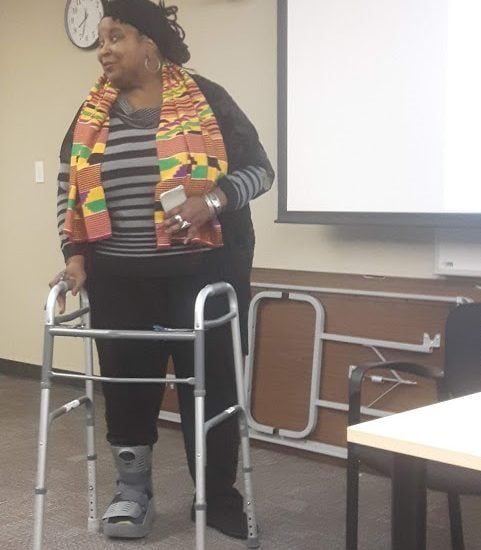KJIPUKTUK (Halifax) – Long time trade union and anti-racism activist Dr. Lynn Jones is upset about the way she was treated by several staff members during a recent visit to the QEII emergency department in Halifax.
She tells the Nova Scotia Advocate that staff made her feel as if she was ignorant of her own health, and implied that her case wasn’t serious, and probably didn’t warrant a visit to the ER. Then, on her way out some eight hours later and still very sick, she was bluntly told she wasn’t allowed to sit down in an area where nobody was sitting at the time.

This is what happened.
One evening earlier this month Dr. Jones got very sick, was coughing uncontrollably and had great difficulty breathing. She called the Nurses Help Line, and a registered nurse advised her to call an ambulance without delay. She decided to call a friend instead, who drove her to the ER around 11 PM.
There was nobody else at the intake counter. When Dr. Jones mentioned that the nurse at the help line recommended that she go to the ER, she was told that was what these nurses always say, suggesting that her case probably didn’t warrant a visit. An intake nurse then took her blood pressure and listened to her breathing using a stethoscope.
We will let Dr. Jones tell the story.
“I asked the nurse, ‘Did you see anything?’ She gives a snarky response and says something like, ‘Well, these stethoscopes aren’t to see through, and I don’t have ESP.’”
“I was offended, because I was made to feel as if I was stupid, as if I didn’t know what a stethoscope is,” says Jones. “I told her nicely that a condescending and demeaning response like that was not a good way to deal with the public. ‘You could have just said that you’re not making the assessment and wait for the doctor to see me.’ The nurse responded that was not her intention to be sarcastic, and I replied, ‘I know it wasn’t your intention, but it is certainly how it was received.’”
After a long wait Dr. Jones was seen by a doctor, X-rays were taken, and three different medications were prescribed to bring a serious lung infection under control. She was told to return immediately and without waiting to the ER if her health didn’t improve in a couple of days.
On her way out of the examination area, early the next morning, things really took a nasty turn.
Dr. Jones, who uses a walker and was still feeling very sick, comes out of the double doors of the examination room, and noticing that there is nobody lining up at the intake counter and that all seats in the triage area are empty, sits down on the chair closest to the exit to call somebody to drive her home.
Here is Dr. Jones telling us what happened next.
“One of the people behind the counter came all the way over to tell me that I can’t sit there, not to sit there. I’m looking at the woman, I can’t believe it. Keep in mind. There’s nobody there. It’s eight o’clock in the morning. She didn’t say, go sit over here instead. No, it’s get off the chair. I said, ‘Well, I’m just here making a call.’”
So once again an attempt is made to make Dr. Jones feel as if she is ignorant.
“That nurse acts like I can’t read, says Dr. Jones, she points at the sign and says ‘if you read this sign, this is the triage area. You cannot sit here.’That’s when things escalated. That nurse started raising her voice, and tells me she’s the RN, and that it is her job to get me out of these chairs. And so I nicely said, ‘well, where would you have me sit?’ But she couldn’t answer, because the way that area set up, there are no public seats. There’s only the triage seats. That she couldn’t answer.”
Next, security staff arrive, and the nurse moves into what Dr. Jones feels is her personal space, while continuing to tell her that she cannot sit there. Dr. Jones holds up her hand to stop the nurse from getting even closer. Dr. Jones advises the nurse that she will be sitting here until her drive arrives. At that point the nurse returns to the counter, as she audibly declares “this is what I have to put up with here.”
Meanwhile, a white person looking for a relative is invited by security to sit down on the very same chairs that Dr. Jones is told are strictly for people waiting for triage!
Between the time Dr. Jones sat down and the arrival of her ride, maybe 20 minutes later, nobody else needed any of the chairs in the triage area. Two new people arrived in the triage area, says Dr. Jones, but they were assisted immediately since there was no line up.
On top of all this, a parking attendant who had witnessed part of the earlier exchange felt compelled to lecture and reprimand Dr. Jones for not treating the nurse with respect. Once again a very sick Dr. Jones was forced to respond to a situation not of her making.
“In many instances that African Nova Scotian people experience that they don’t feel welcome in the health system”
Rudeness and especially racist behaviour by staff are offensive at any time and in any setting, but when it occurs in a hospital setting the consequences can be very serious, says Sharon Davis-Murdoch, co-president of the Health Association of African Canadians (HAAC). HAAC has been advocating for a healthcare system without barriers for Black Nova Scotians for almost two decades now.
“Anecdotally we have been told in many instances that African Nova Scotian people experience that they don’t feel welcome in the health system, that they don’t feel supported in navigating the system, and that they don’t see themselves represented. They don’t always feel that they are respected, or understood, or assisted in culturally specific ways to navigate the system,” Davis-Murdoch says.
In the case of Dr. Jones the clinical care she received was fine, but that too is not always the case, says Davis-Murdoch. And this lack of cultural competence in clinical care can result in misdiagnosis, because African Nova Scotian patients were not heard, or properly engaged. As well, at times knowledge is lacking among physicians with respect to diseases and conditions that disproportionately affect people of African descent.
Hard facts and figures are much needed, says Davis-Murdoch.
“One of the most important aspects of HAAC’s work since 2000 has been to advocate for the collection of disaggregated MSI health data. Government has agreed to move on this, but we’re waiting for action,” says Davis-Murdoch.
HAAC for many years has emphasized the need for change in terms of cultural competence in the delivery of services, and the need for culturally conscious clinical care, she says.
Cultural competence here does not just apply to interactions with the African Nova Scotian community, it is equally crucial when dealing with persons of colour from any national origin, religious communities, gay and trans people, and so on.
In 2018 the NSHA initiated the African Nova Scotian Health Strategy, to create equitable health care, services and programs and to lower the level of health disparities for Black Nova Scotians.
“Because the strategy has not been publicly launched, it’s difficult for me to speak about it. But what I would say is that we have made recommendations over many years, about the need for system change with respect to cultural competence in attitude and the delivery of services and the need for clinically culturally competent care,” Davis-Murdoch says.
“When I walk into a doctor’s office or a clinic, any time I’m dealing with any kind of health professional, even the front desk receptionist, the way in which I am greeted, and the comfort I have with that interaction, if that experience is good, than that is moving toward cultural competence,” says Davis-Murdoch. “And when the experience is bad, then we’re not even on the way to that.”
As examples of programs that reflect that kind of cultural competence Davis-Murdoch cites the Nova Scotia Brotherhood Initiative (NSBI), a primary care program targeting men of African descent in HRM. A second example, the Matter of Black Health (MBH) project, has three health coaches of Afican ancestry working in the communities, gain trust and support community members in managing and preventing chronic diseases, in particular diabetes. Funding for MBH has dried up, Davis-Murdoch adds.
The Nova Scotia Health Authority responds
We asked the Nova Scotia Health Authority (NSHA) whether it is aware that at least some people of African descent aren’t happy about the way they are treated in the health system, and if so, what the NSHA is doing to address these problems. We also asked about Dr. Jones’ experience at the ER.
“It is deeply troubling to hear that any patient feels they have experienced discrimination while receiving care. As an organization, we strive to be patient-focused and don’t tolerate discrimination within our workplace or care delivery sites. We apologize to the patient for her negative experience and encourage her to reach out to our patient relations team so we can follow-up on her concerns,” writes Carmelle d’Entremont, Vice President, People and Organizational Development.
In terms of addressing these issues, d’Entremont references ongoing cultural competence training and education for staff and volunteers, and mentions its efforts to engage vulnerable populations in health services planning. As well, the NSHA is hiring an African Nova Scotian Services Consultant to champion inclusion. Read the full response here.
We also asked how many nurses at triage stations province-wide identify as Black. No such statistics exist, the NSHA told us.
The NSHA also suggested that Dr. Jones contact the patient relations team to ensure her concerns are formally captured and shared with the appropriate staff and managers.
“I have no desire whatsoever to talk to anybody there,” says Dr. Jones. “This happened when I was in the hospital before. Every time you go in that system, it happens, as other people continually tell me. They need to put something in place to address these issues and they refuse to do it.”
“In all those years I have never even seen a person that looks like me at that desk. That’s the very least one would have expected that they would have been able to do.”
See also: Open letter to the Premier: Seven actions to stop systemic racism in our health care system
With a special thanks to our generous donors who make publication of the Nova Scotia Advocate possible.
Subscribe to the Nova Scotia Advocate weekly digest and never miss an article again. It’s free!




Same happened to me over the years in several NS hospitals: nurses line each time told me to go to hospital asap. I wait hours (once 7 and 1/2) to not even be assessed properly or at all. Doctors, radiologist techs, several times rush the “assessment”, talk down to me, rush me out before I’m even dressed. Despite OBVIOUS symptoms, positive tests, family history, they give a ridiculous misdiagnosis and send me on my way without further necessary testing or treatment. Once I called the doctor out and demanded assessment, based on my knowledge as a health care provider, and he removed me from the regular waiting room and even doctors waiting room, to a completely empty room with lights off and kept off. I’m a White female. You get treated differently if you dare to question the doctor or simply beg for assessment. This, unfortunately, is the norm for patient treatment in NS.
#LynnJones unfortunately this happened to my daughter. While waiting several hours in pain the Male nurse who assessed her told her that she was probably fine. Another hour passed and she became more ill trying to get medical staff attention by waving to the Male nurse on duty, she lost consciousness. Where she passed out my daughter body was blocking the door, making it hard for staff to get to her. The Male nurse tried to make a cover story, saying my daughter threw herself at the door. When my daughter came to, she was facing exploratory surgery.
No one had apologized. By the time I arrived at the hospital there it was a different shift.
Unacceptable treatment.
I am so sorry this happened. Unfortunately I don’t know that it happens to only people of colour. I had an ER experience that was great either. Met a snarky nurse also and a young resident who sent me home without tests or treatment, telling me the ER was for emergencies. My bowel ruptured about 30 hours later and I walked.around that for four day. I returned and had surgery I was never told anything about and woke up with an ostomy. All in all, I think most ppl there are okay, but greatly.overworked and some could benefit with some kind of.sensitivity.or empathy training.